Islamic Republic of Iran vs. United States of America
VerifiedAdded on 2022/08/26
|11
|2754
|44
AI Summary
Contribute Materials
Your contribution can guide someone’s learning journey. Share your
documents today.
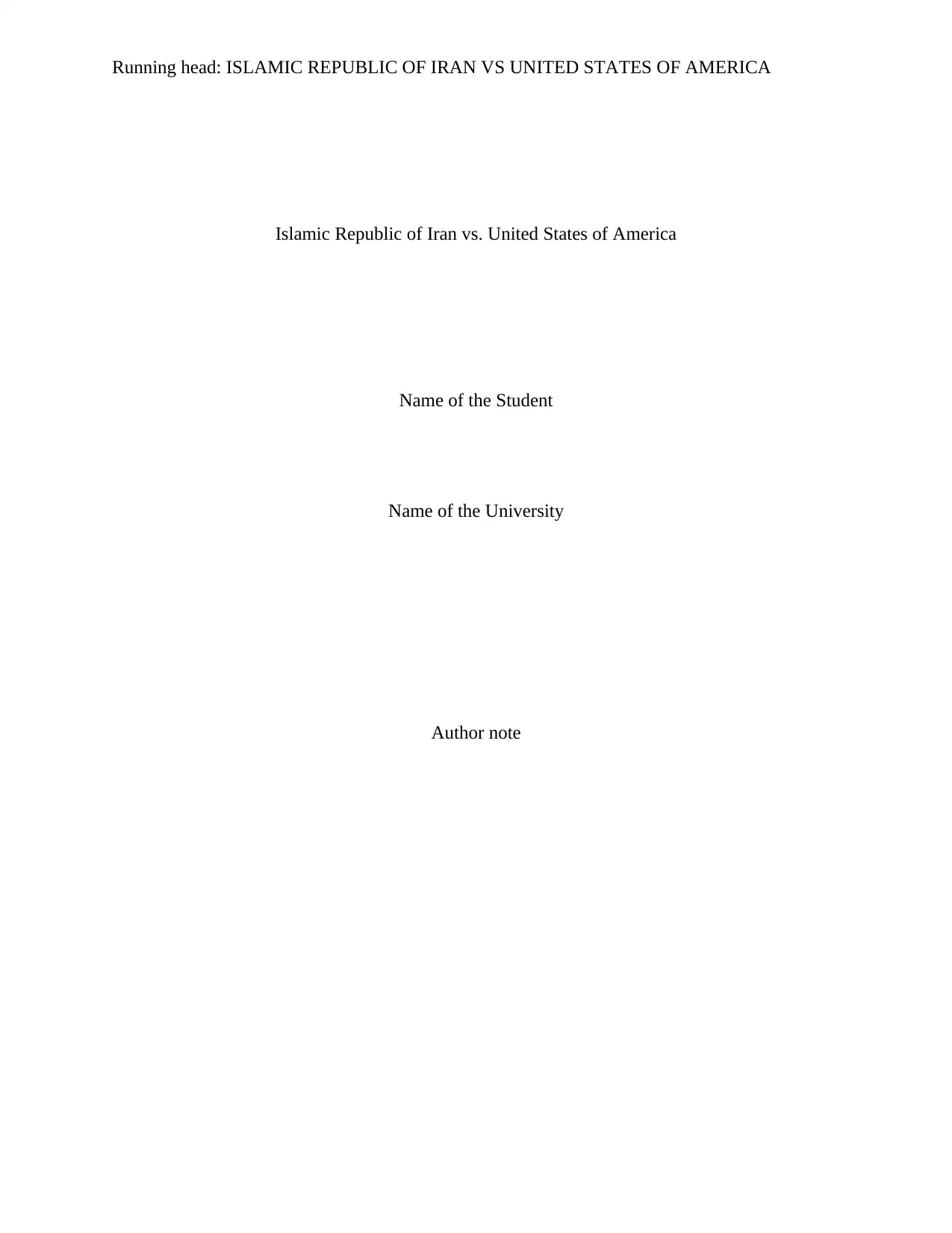
Running head: ISLAMIC REPUBLIC OF IRAN VS UNITED STATES OF AMERICA
Islamic Republic of Iran vs. United States of America
Name of the Student
Name of the University
Author note
Islamic Republic of Iran vs. United States of America
Name of the Student
Name of the University
Author note
Secure Best Marks with AI Grader
Need help grading? Try our AI Grader for instant feedback on your assignments.
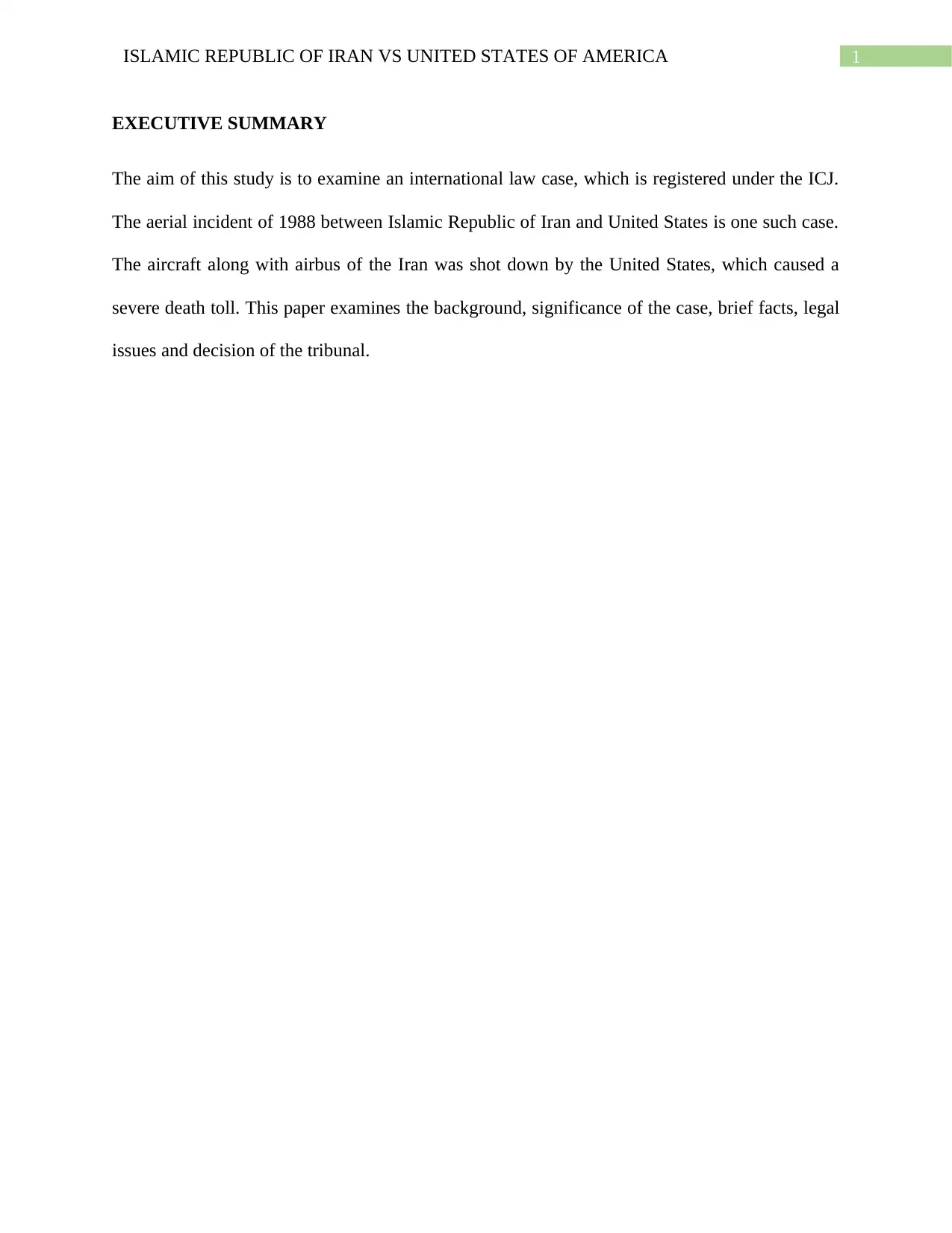
1ISLAMIC REPUBLIC OF IRAN VS UNITED STATES OF AMERICA
EXECUTIVE SUMMARY
The aim of this study is to examine an international law case, which is registered under the ICJ.
The aerial incident of 1988 between Islamic Republic of Iran and United States is one such case.
The aircraft along with airbus of the Iran was shot down by the United States, which caused a
severe death toll. This paper examines the background, significance of the case, brief facts, legal
issues and decision of the tribunal.
EXECUTIVE SUMMARY
The aim of this study is to examine an international law case, which is registered under the ICJ.
The aerial incident of 1988 between Islamic Republic of Iran and United States is one such case.
The aircraft along with airbus of the Iran was shot down by the United States, which caused a
severe death toll. This paper examines the background, significance of the case, brief facts, legal
issues and decision of the tribunal.
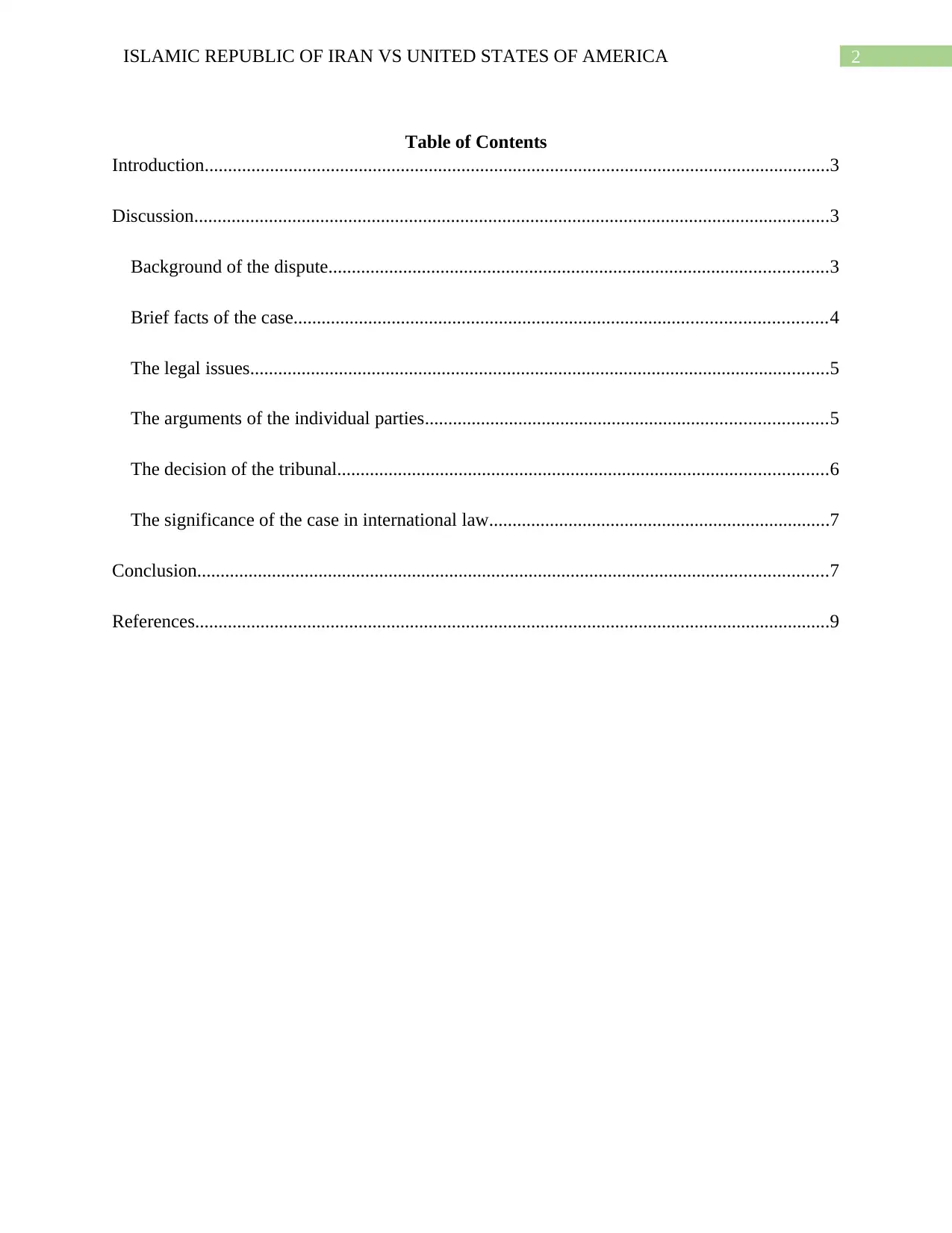
2ISLAMIC REPUBLIC OF IRAN VS UNITED STATES OF AMERICA
Table of Contents
Introduction......................................................................................................................................3
Discussion........................................................................................................................................3
Background of the dispute...........................................................................................................3
Brief facts of the case..................................................................................................................4
The legal issues............................................................................................................................5
The arguments of the individual parties......................................................................................5
The decision of the tribunal.........................................................................................................6
The significance of the case in international law.........................................................................7
Conclusion.......................................................................................................................................7
References........................................................................................................................................9
Table of Contents
Introduction......................................................................................................................................3
Discussion........................................................................................................................................3
Background of the dispute...........................................................................................................3
Brief facts of the case..................................................................................................................4
The legal issues............................................................................................................................5
The arguments of the individual parties......................................................................................5
The decision of the tribunal.........................................................................................................6
The significance of the case in international law.........................................................................7
Conclusion.......................................................................................................................................7
References........................................................................................................................................9
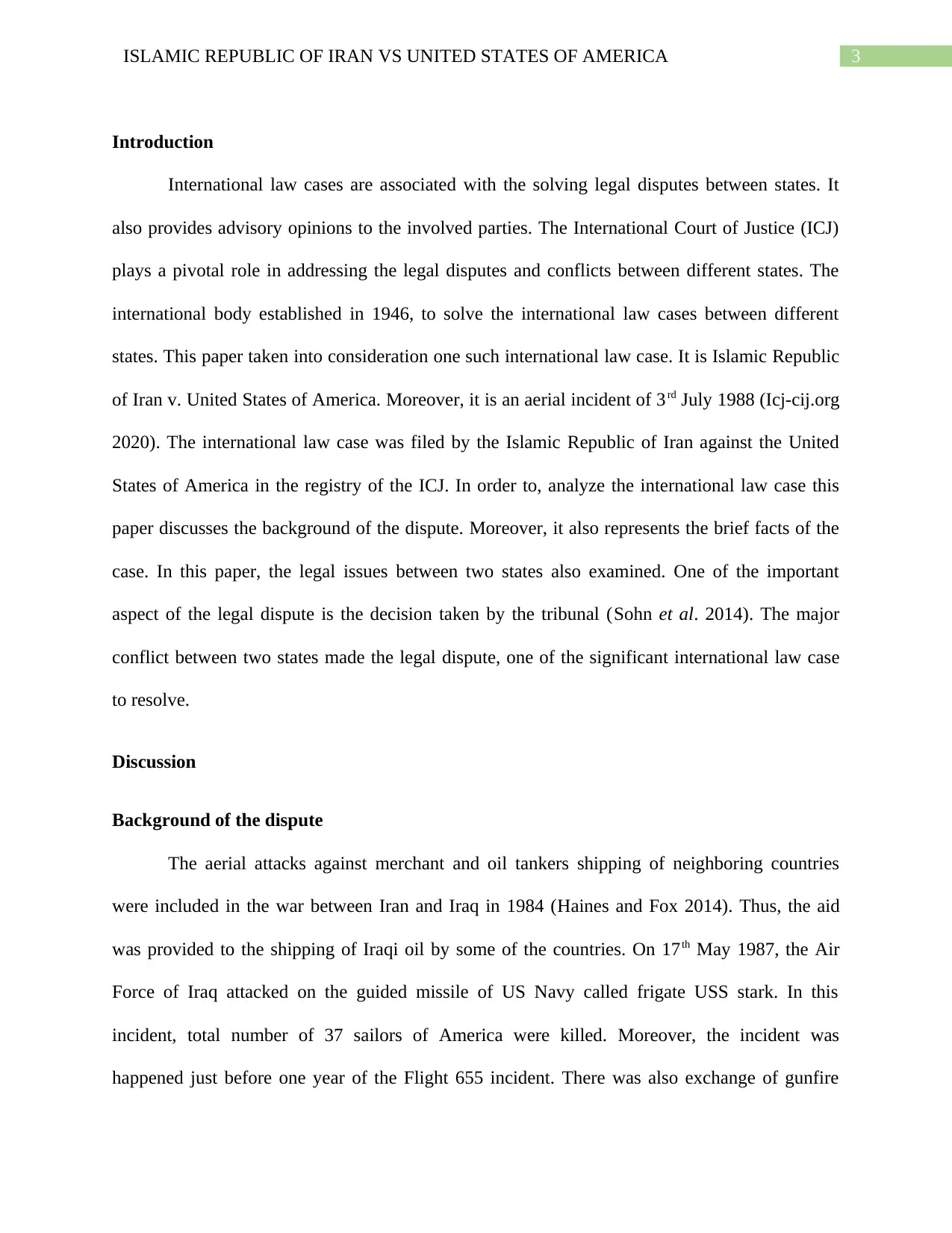
3ISLAMIC REPUBLIC OF IRAN VS UNITED STATES OF AMERICA
Introduction
International law cases are associated with the solving legal disputes between states. It
also provides advisory opinions to the involved parties. The International Court of Justice (ICJ)
plays a pivotal role in addressing the legal disputes and conflicts between different states. The
international body established in 1946, to solve the international law cases between different
states. This paper taken into consideration one such international law case. It is Islamic Republic
of Iran v. United States of America. Moreover, it is an aerial incident of 3rd July 1988 (Icj-cij.org
2020). The international law case was filed by the Islamic Republic of Iran against the United
States of America in the registry of the ICJ. In order to, analyze the international law case this
paper discusses the background of the dispute. Moreover, it also represents the brief facts of the
case. In this paper, the legal issues between two states also examined. One of the important
aspect of the legal dispute is the decision taken by the tribunal (Sohn et al. 2014). The major
conflict between two states made the legal dispute, one of the significant international law case
to resolve.
Discussion
Background of the dispute
The aerial attacks against merchant and oil tankers shipping of neighboring countries
were included in the war between Iran and Iraq in 1984 (Haines and Fox 2014). Thus, the aid
was provided to the shipping of Iraqi oil by some of the countries. On 17th May 1987, the Air
Force of Iraq attacked on the guided missile of US Navy called frigate USS stark. In this
incident, total number of 37 sailors of America were killed. Moreover, the incident was
happened just before one year of the Flight 655 incident. There was also exchange of gunfire
Introduction
International law cases are associated with the solving legal disputes between states. It
also provides advisory opinions to the involved parties. The International Court of Justice (ICJ)
plays a pivotal role in addressing the legal disputes and conflicts between different states. The
international body established in 1946, to solve the international law cases between different
states. This paper taken into consideration one such international law case. It is Islamic Republic
of Iran v. United States of America. Moreover, it is an aerial incident of 3rd July 1988 (Icj-cij.org
2020). The international law case was filed by the Islamic Republic of Iran against the United
States of America in the registry of the ICJ. In order to, analyze the international law case this
paper discusses the background of the dispute. Moreover, it also represents the brief facts of the
case. In this paper, the legal issues between two states also examined. One of the important
aspect of the legal dispute is the decision taken by the tribunal (Sohn et al. 2014). The major
conflict between two states made the legal dispute, one of the significant international law case
to resolve.
Discussion
Background of the dispute
The aerial attacks against merchant and oil tankers shipping of neighboring countries
were included in the war between Iran and Iraq in 1984 (Haines and Fox 2014). Thus, the aid
was provided to the shipping of Iraqi oil by some of the countries. On 17th May 1987, the Air
Force of Iraq attacked on the guided missile of US Navy called frigate USS stark. In this
incident, total number of 37 sailors of America were killed. Moreover, the incident was
happened just before one year of the Flight 655 incident. There was also exchange of gunfire
Secure Best Marks with AI Grader
Need help grading? Try our AI Grader for instant feedback on your assignments.
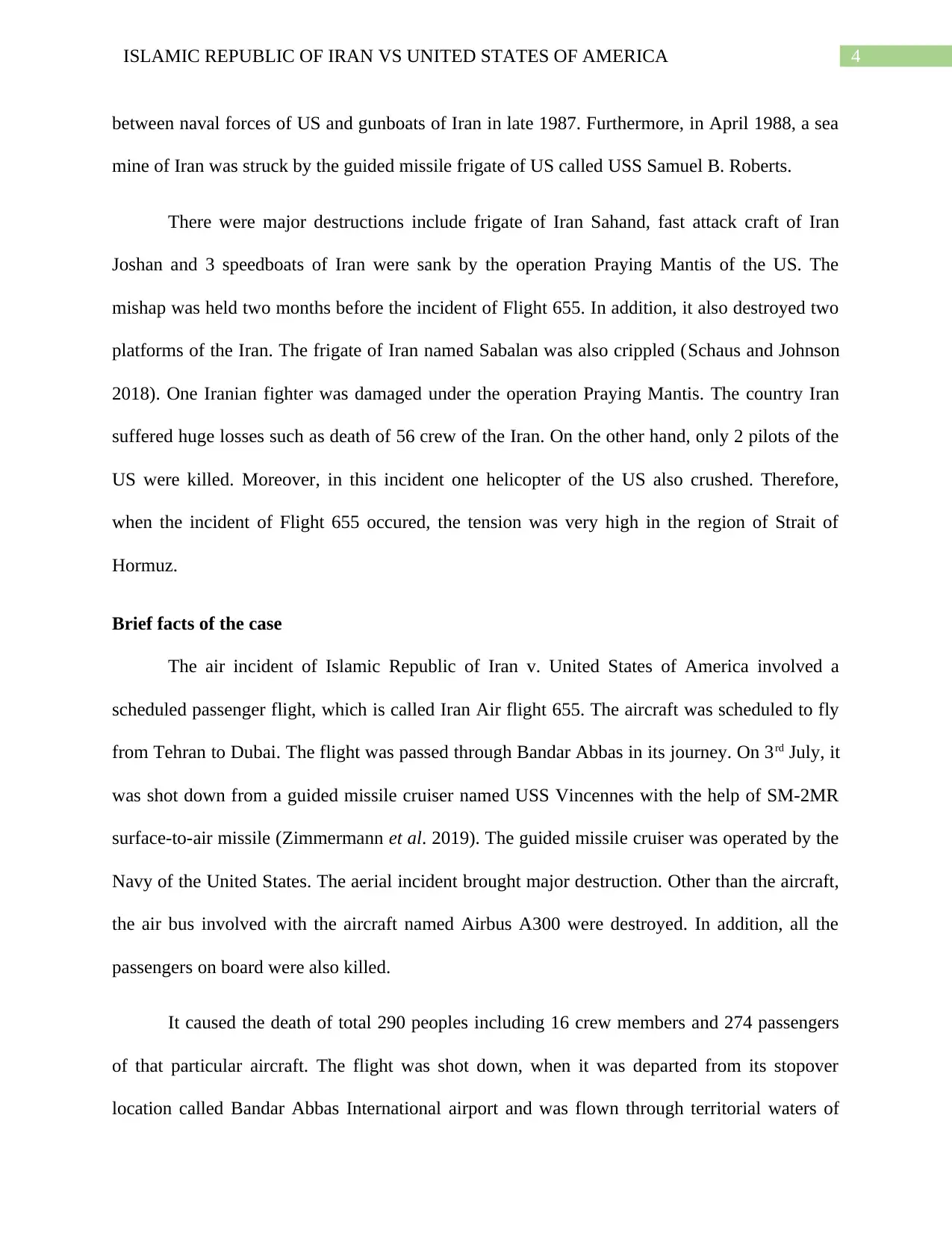
4ISLAMIC REPUBLIC OF IRAN VS UNITED STATES OF AMERICA
between naval forces of US and gunboats of Iran in late 1987. Furthermore, in April 1988, a sea
mine of Iran was struck by the guided missile frigate of US called USS Samuel B. Roberts.
There were major destructions include frigate of Iran Sahand, fast attack craft of Iran
Joshan and 3 speedboats of Iran were sank by the operation Praying Mantis of the US. The
mishap was held two months before the incident of Flight 655. In addition, it also destroyed two
platforms of the Iran. The frigate of Iran named Sabalan was also crippled (Schaus and Johnson
2018). One Iranian fighter was damaged under the operation Praying Mantis. The country Iran
suffered huge losses such as death of 56 crew of the Iran. On the other hand, only 2 pilots of the
US were killed. Moreover, in this incident one helicopter of the US also crushed. Therefore,
when the incident of Flight 655 occured, the tension was very high in the region of Strait of
Hormuz.
Brief facts of the case
The air incident of Islamic Republic of Iran v. United States of America involved a
scheduled passenger flight, which is called Iran Air flight 655. The aircraft was scheduled to fly
from Tehran to Dubai. The flight was passed through Bandar Abbas in its journey. On 3rd July, it
was shot down from a guided missile cruiser named USS Vincennes with the help of SM-2MR
surface-to-air missile (Zimmermann et al. 2019). The guided missile cruiser was operated by the
Navy of the United States. The aerial incident brought major destruction. Other than the aircraft,
the air bus involved with the aircraft named Airbus A300 were destroyed. In addition, all the
passengers on board were also killed.
It caused the death of total 290 peoples including 16 crew members and 274 passengers
of that particular aircraft. The flight was shot down, when it was departed from its stopover
location called Bandar Abbas International airport and was flown through territorial waters of
between naval forces of US and gunboats of Iran in late 1987. Furthermore, in April 1988, a sea
mine of Iran was struck by the guided missile frigate of US called USS Samuel B. Roberts.
There were major destructions include frigate of Iran Sahand, fast attack craft of Iran
Joshan and 3 speedboats of Iran were sank by the operation Praying Mantis of the US. The
mishap was held two months before the incident of Flight 655. In addition, it also destroyed two
platforms of the Iran. The frigate of Iran named Sabalan was also crippled (Schaus and Johnson
2018). One Iranian fighter was damaged under the operation Praying Mantis. The country Iran
suffered huge losses such as death of 56 crew of the Iran. On the other hand, only 2 pilots of the
US were killed. Moreover, in this incident one helicopter of the US also crushed. Therefore,
when the incident of Flight 655 occured, the tension was very high in the region of Strait of
Hormuz.
Brief facts of the case
The air incident of Islamic Republic of Iran v. United States of America involved a
scheduled passenger flight, which is called Iran Air flight 655. The aircraft was scheduled to fly
from Tehran to Dubai. The flight was passed through Bandar Abbas in its journey. On 3rd July, it
was shot down from a guided missile cruiser named USS Vincennes with the help of SM-2MR
surface-to-air missile (Zimmermann et al. 2019). The guided missile cruiser was operated by the
Navy of the United States. The aerial incident brought major destruction. Other than the aircraft,
the air bus involved with the aircraft named Airbus A300 were destroyed. In addition, all the
passengers on board were also killed.
It caused the death of total 290 peoples including 16 crew members and 274 passengers
of that particular aircraft. The flight was shot down, when it was departed from its stopover
location called Bandar Abbas International airport and was flown through territorial waters of
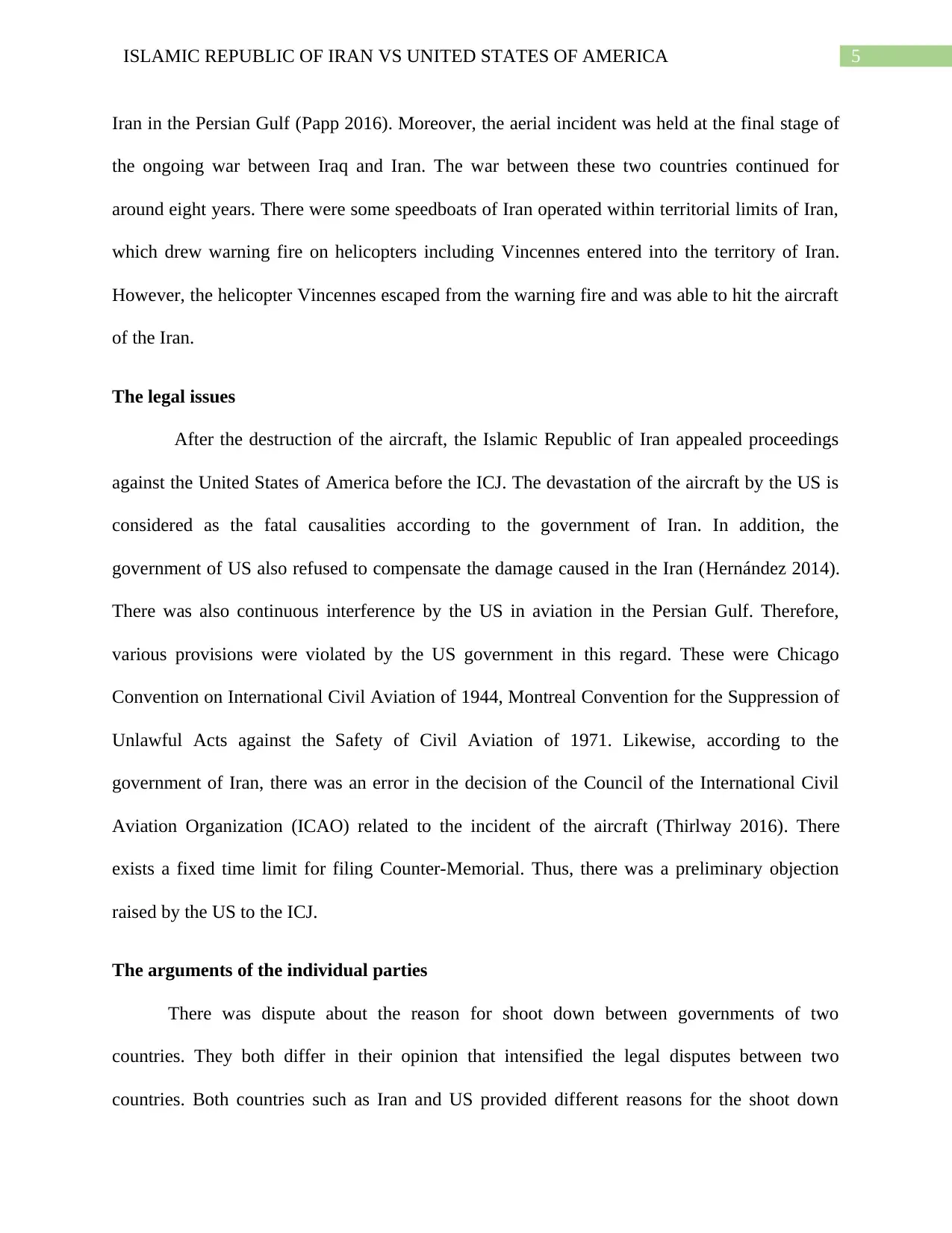
5ISLAMIC REPUBLIC OF IRAN VS UNITED STATES OF AMERICA
Iran in the Persian Gulf (Papp 2016). Moreover, the aerial incident was held at the final stage of
the ongoing war between Iraq and Iran. The war between these two countries continued for
around eight years. There were some speedboats of Iran operated within territorial limits of Iran,
which drew warning fire on helicopters including Vincennes entered into the territory of Iran.
However, the helicopter Vincennes escaped from the warning fire and was able to hit the aircraft
of the Iran.
The legal issues
After the destruction of the aircraft, the Islamic Republic of Iran appealed proceedings
against the United States of America before the ICJ. The devastation of the aircraft by the US is
considered as the fatal causalities according to the government of Iran. In addition, the
government of US also refused to compensate the damage caused in the Iran (Hernández 2014).
There was also continuous interference by the US in aviation in the Persian Gulf. Therefore,
various provisions were violated by the US government in this regard. These were Chicago
Convention on International Civil Aviation of 1944, Montreal Convention for the Suppression of
Unlawful Acts against the Safety of Civil Aviation of 1971. Likewise, according to the
government of Iran, there was an error in the decision of the Council of the International Civil
Aviation Organization (ICAO) related to the incident of the aircraft (Thirlway 2016). There
exists a fixed time limit for filing Counter-Memorial. Thus, there was a preliminary objection
raised by the US to the ICJ.
The arguments of the individual parties
There was dispute about the reason for shoot down between governments of two
countries. They both differ in their opinion that intensified the legal disputes between two
countries. Both countries such as Iran and US provided different reasons for the shoot down
Iran in the Persian Gulf (Papp 2016). Moreover, the aerial incident was held at the final stage of
the ongoing war between Iraq and Iran. The war between these two countries continued for
around eight years. There were some speedboats of Iran operated within territorial limits of Iran,
which drew warning fire on helicopters including Vincennes entered into the territory of Iran.
However, the helicopter Vincennes escaped from the warning fire and was able to hit the aircraft
of the Iran.
The legal issues
After the destruction of the aircraft, the Islamic Republic of Iran appealed proceedings
against the United States of America before the ICJ. The devastation of the aircraft by the US is
considered as the fatal causalities according to the government of Iran. In addition, the
government of US also refused to compensate the damage caused in the Iran (Hernández 2014).
There was also continuous interference by the US in aviation in the Persian Gulf. Therefore,
various provisions were violated by the US government in this regard. These were Chicago
Convention on International Civil Aviation of 1944, Montreal Convention for the Suppression of
Unlawful Acts against the Safety of Civil Aviation of 1971. Likewise, according to the
government of Iran, there was an error in the decision of the Council of the International Civil
Aviation Organization (ICAO) related to the incident of the aircraft (Thirlway 2016). There
exists a fixed time limit for filing Counter-Memorial. Thus, there was a preliminary objection
raised by the US to the ICJ.
The arguments of the individual parties
There was dispute about the reason for shoot down between governments of two
countries. They both differ in their opinion that intensified the legal disputes between two
countries. Both countries such as Iran and US provided different reasons for the shoot down
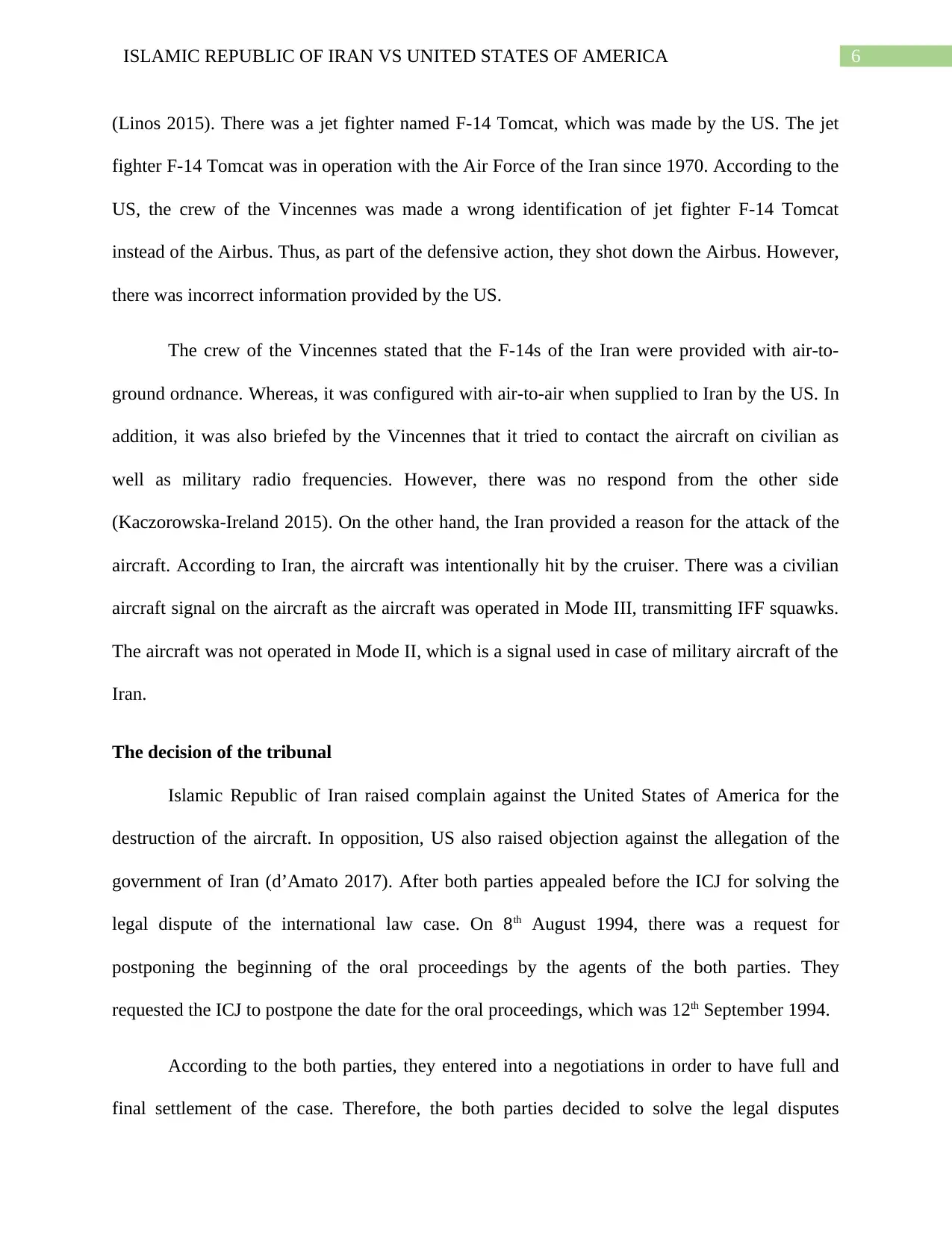
6ISLAMIC REPUBLIC OF IRAN VS UNITED STATES OF AMERICA
(Linos 2015). There was a jet fighter named F-14 Tomcat, which was made by the US. The jet
fighter F-14 Tomcat was in operation with the Air Force of the Iran since 1970. According to the
US, the crew of the Vincennes was made a wrong identification of jet fighter F-14 Tomcat
instead of the Airbus. Thus, as part of the defensive action, they shot down the Airbus. However,
there was incorrect information provided by the US.
The crew of the Vincennes stated that the F-14s of the Iran were provided with air-to-
ground ordnance. Whereas, it was configured with air-to-air when supplied to Iran by the US. In
addition, it was also briefed by the Vincennes that it tried to contact the aircraft on civilian as
well as military radio frequencies. However, there was no respond from the other side
(Kaczorowska-Ireland 2015). On the other hand, the Iran provided a reason for the attack of the
aircraft. According to Iran, the aircraft was intentionally hit by the cruiser. There was a civilian
aircraft signal on the aircraft as the aircraft was operated in Mode III, transmitting IFF squawks.
The aircraft was not operated in Mode II, which is a signal used in case of military aircraft of the
Iran.
The decision of the tribunal
Islamic Republic of Iran raised complain against the United States of America for the
destruction of the aircraft. In opposition, US also raised objection against the allegation of the
government of Iran (d’Amato 2017). After both parties appealed before the ICJ for solving the
legal dispute of the international law case. On 8th August 1994, there was a request for
postponing the beginning of the oral proceedings by the agents of the both parties. They
requested the ICJ to postpone the date for the oral proceedings, which was 12th September 1994.
According to the both parties, they entered into a negotiations in order to have full and
final settlement of the case. Therefore, the both parties decided to solve the legal disputes
(Linos 2015). There was a jet fighter named F-14 Tomcat, which was made by the US. The jet
fighter F-14 Tomcat was in operation with the Air Force of the Iran since 1970. According to the
US, the crew of the Vincennes was made a wrong identification of jet fighter F-14 Tomcat
instead of the Airbus. Thus, as part of the defensive action, they shot down the Airbus. However,
there was incorrect information provided by the US.
The crew of the Vincennes stated that the F-14s of the Iran were provided with air-to-
ground ordnance. Whereas, it was configured with air-to-air when supplied to Iran by the US. In
addition, it was also briefed by the Vincennes that it tried to contact the aircraft on civilian as
well as military radio frequencies. However, there was no respond from the other side
(Kaczorowska-Ireland 2015). On the other hand, the Iran provided a reason for the attack of the
aircraft. According to Iran, the aircraft was intentionally hit by the cruiser. There was a civilian
aircraft signal on the aircraft as the aircraft was operated in Mode III, transmitting IFF squawks.
The aircraft was not operated in Mode II, which is a signal used in case of military aircraft of the
Iran.
The decision of the tribunal
Islamic Republic of Iran raised complain against the United States of America for the
destruction of the aircraft. In opposition, US also raised objection against the allegation of the
government of Iran (d’Amato 2017). After both parties appealed before the ICJ for solving the
legal dispute of the international law case. On 8th August 1994, there was a request for
postponing the beginning of the oral proceedings by the agents of the both parties. They
requested the ICJ to postpone the date for the oral proceedings, which was 12th September 1994.
According to the both parties, they entered into a negotiations in order to have full and
final settlement of the case. Therefore, the both parties decided to solve the legal disputes
Paraphrase This Document
Need a fresh take? Get an instant paraphrase of this document with our AI Paraphraser
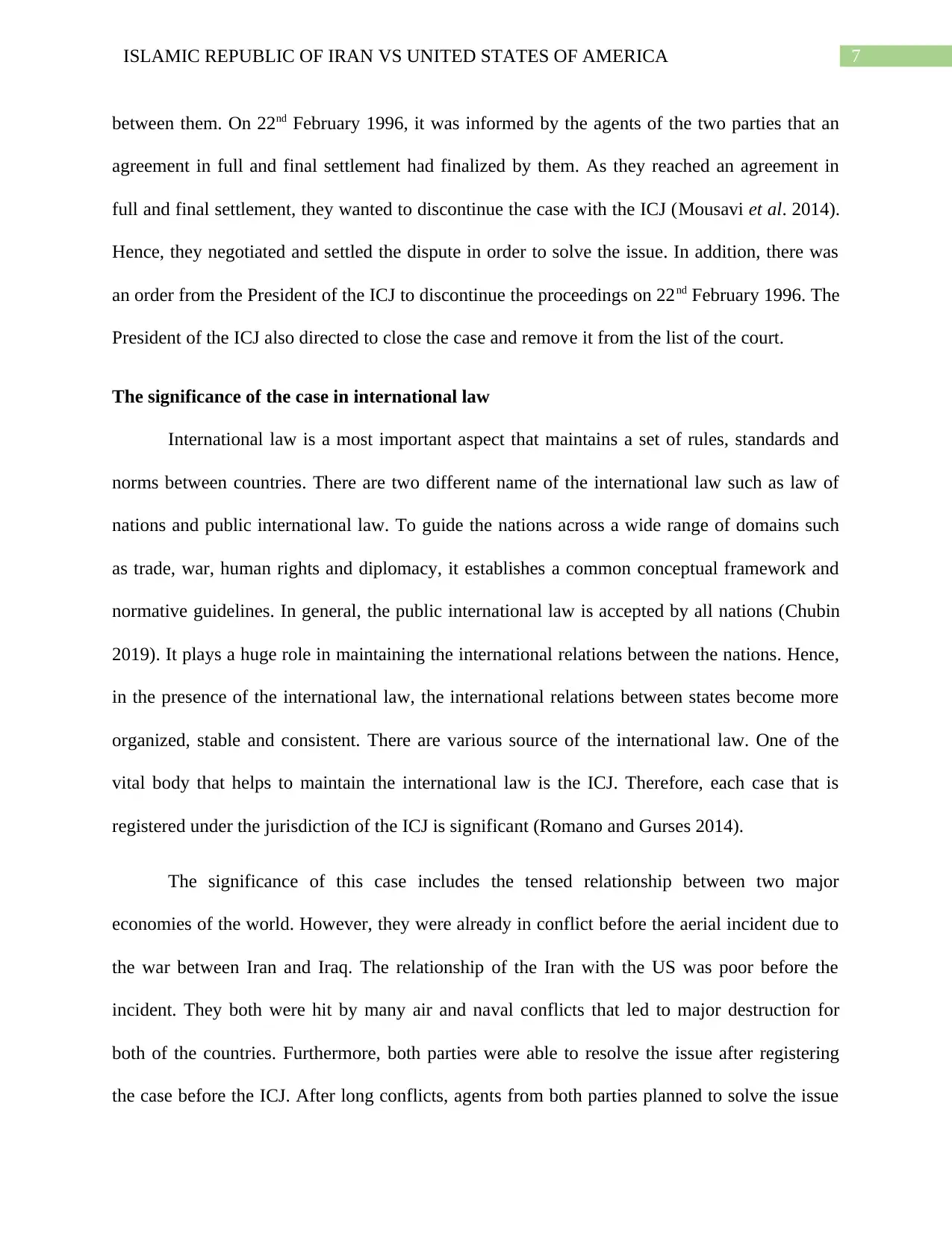
7ISLAMIC REPUBLIC OF IRAN VS UNITED STATES OF AMERICA
between them. On 22nd February 1996, it was informed by the agents of the two parties that an
agreement in full and final settlement had finalized by them. As they reached an agreement in
full and final settlement, they wanted to discontinue the case with the ICJ (Mousavi et al. 2014).
Hence, they negotiated and settled the dispute in order to solve the issue. In addition, there was
an order from the President of the ICJ to discontinue the proceedings on 22nd February 1996. The
President of the ICJ also directed to close the case and remove it from the list of the court.
The significance of the case in international law
International law is a most important aspect that maintains a set of rules, standards and
norms between countries. There are two different name of the international law such as law of
nations and public international law. To guide the nations across a wide range of domains such
as trade, war, human rights and diplomacy, it establishes a common conceptual framework and
normative guidelines. In general, the public international law is accepted by all nations (Chubin
2019). It plays a huge role in maintaining the international relations between the nations. Hence,
in the presence of the international law, the international relations between states become more
organized, stable and consistent. There are various source of the international law. One of the
vital body that helps to maintain the international law is the ICJ. Therefore, each case that is
registered under the jurisdiction of the ICJ is significant (Romano and Gurses 2014).
The significance of this case includes the tensed relationship between two major
economies of the world. However, they were already in conflict before the aerial incident due to
the war between Iran and Iraq. The relationship of the Iran with the US was poor before the
incident. They both were hit by many air and naval conflicts that led to major destruction for
both of the countries. Furthermore, both parties were able to resolve the issue after registering
the case before the ICJ. After long conflicts, agents from both parties planned to solve the issue
between them. On 22nd February 1996, it was informed by the agents of the two parties that an
agreement in full and final settlement had finalized by them. As they reached an agreement in
full and final settlement, they wanted to discontinue the case with the ICJ (Mousavi et al. 2014).
Hence, they negotiated and settled the dispute in order to solve the issue. In addition, there was
an order from the President of the ICJ to discontinue the proceedings on 22nd February 1996. The
President of the ICJ also directed to close the case and remove it from the list of the court.
The significance of the case in international law
International law is a most important aspect that maintains a set of rules, standards and
norms between countries. There are two different name of the international law such as law of
nations and public international law. To guide the nations across a wide range of domains such
as trade, war, human rights and diplomacy, it establishes a common conceptual framework and
normative guidelines. In general, the public international law is accepted by all nations (Chubin
2019). It plays a huge role in maintaining the international relations between the nations. Hence,
in the presence of the international law, the international relations between states become more
organized, stable and consistent. There are various source of the international law. One of the
vital body that helps to maintain the international law is the ICJ. Therefore, each case that is
registered under the jurisdiction of the ICJ is significant (Romano and Gurses 2014).
The significance of this case includes the tensed relationship between two major
economies of the world. However, they were already in conflict before the aerial incident due to
the war between Iran and Iraq. The relationship of the Iran with the US was poor before the
incident. They both were hit by many air and naval conflicts that led to major destruction for
both of the countries. Furthermore, both parties were able to resolve the issue after registering
the case before the ICJ. After long conflicts, agents from both parties planned to solve the issue
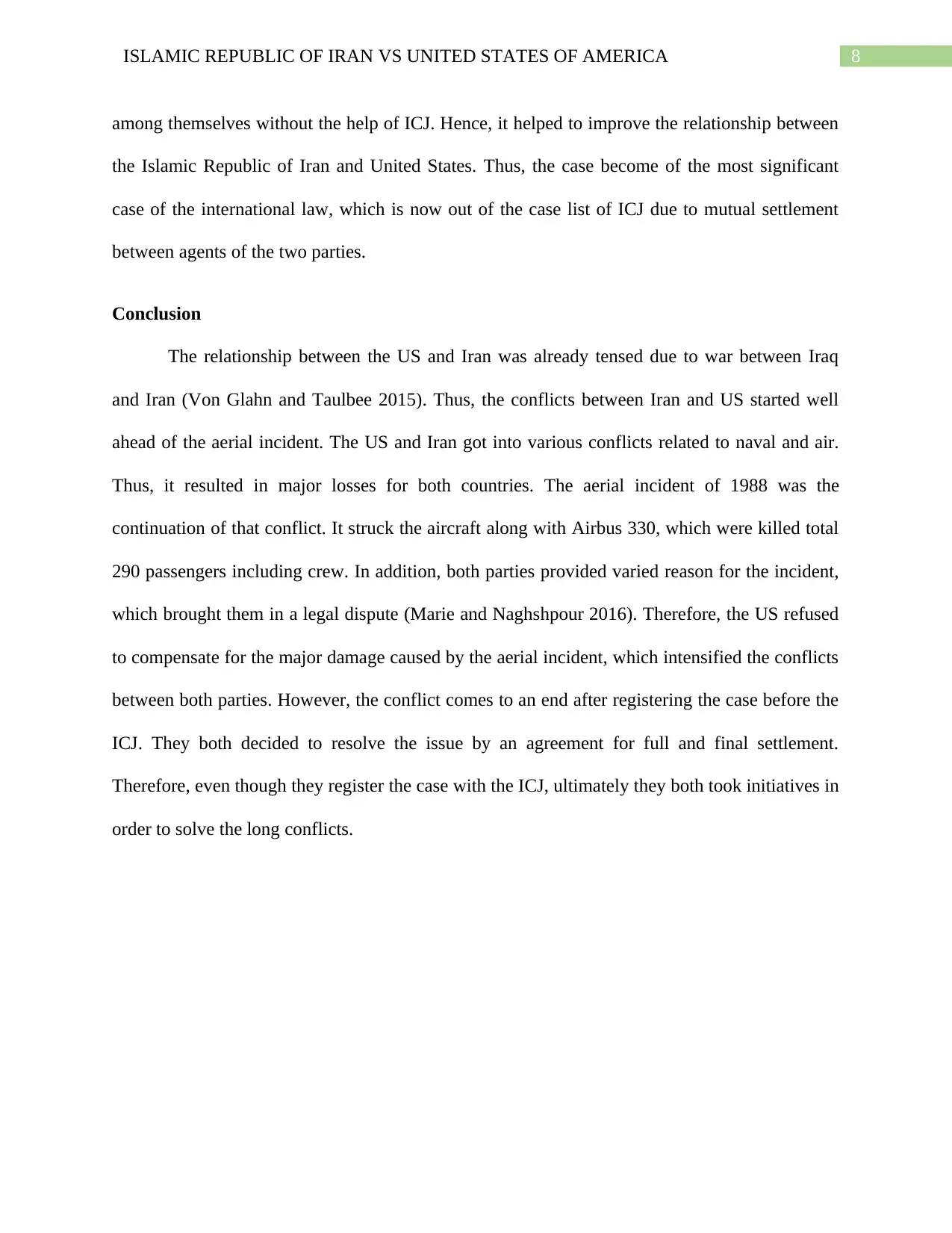
8ISLAMIC REPUBLIC OF IRAN VS UNITED STATES OF AMERICA
among themselves without the help of ICJ. Hence, it helped to improve the relationship between
the Islamic Republic of Iran and United States. Thus, the case become of the most significant
case of the international law, which is now out of the case list of ICJ due to mutual settlement
between agents of the two parties.
Conclusion
The relationship between the US and Iran was already tensed due to war between Iraq
and Iran (Von Glahn and Taulbee 2015). Thus, the conflicts between Iran and US started well
ahead of the aerial incident. The US and Iran got into various conflicts related to naval and air.
Thus, it resulted in major losses for both countries. The aerial incident of 1988 was the
continuation of that conflict. It struck the aircraft along with Airbus 330, which were killed total
290 passengers including crew. In addition, both parties provided varied reason for the incident,
which brought them in a legal dispute (Marie and Naghshpour 2016). Therefore, the US refused
to compensate for the major damage caused by the aerial incident, which intensified the conflicts
between both parties. However, the conflict comes to an end after registering the case before the
ICJ. They both decided to resolve the issue by an agreement for full and final settlement.
Therefore, even though they register the case with the ICJ, ultimately they both took initiatives in
order to solve the long conflicts.
among themselves without the help of ICJ. Hence, it helped to improve the relationship between
the Islamic Republic of Iran and United States. Thus, the case become of the most significant
case of the international law, which is now out of the case list of ICJ due to mutual settlement
between agents of the two parties.
Conclusion
The relationship between the US and Iran was already tensed due to war between Iraq
and Iran (Von Glahn and Taulbee 2015). Thus, the conflicts between Iran and US started well
ahead of the aerial incident. The US and Iran got into various conflicts related to naval and air.
Thus, it resulted in major losses for both countries. The aerial incident of 1988 was the
continuation of that conflict. It struck the aircraft along with Airbus 330, which were killed total
290 passengers including crew. In addition, both parties provided varied reason for the incident,
which brought them in a legal dispute (Marie and Naghshpour 2016). Therefore, the US refused
to compensate for the major damage caused by the aerial incident, which intensified the conflicts
between both parties. However, the conflict comes to an end after registering the case before the
ICJ. They both decided to resolve the issue by an agreement for full and final settlement.
Therefore, even though they register the case with the ICJ, ultimately they both took initiatives in
order to solve the long conflicts.
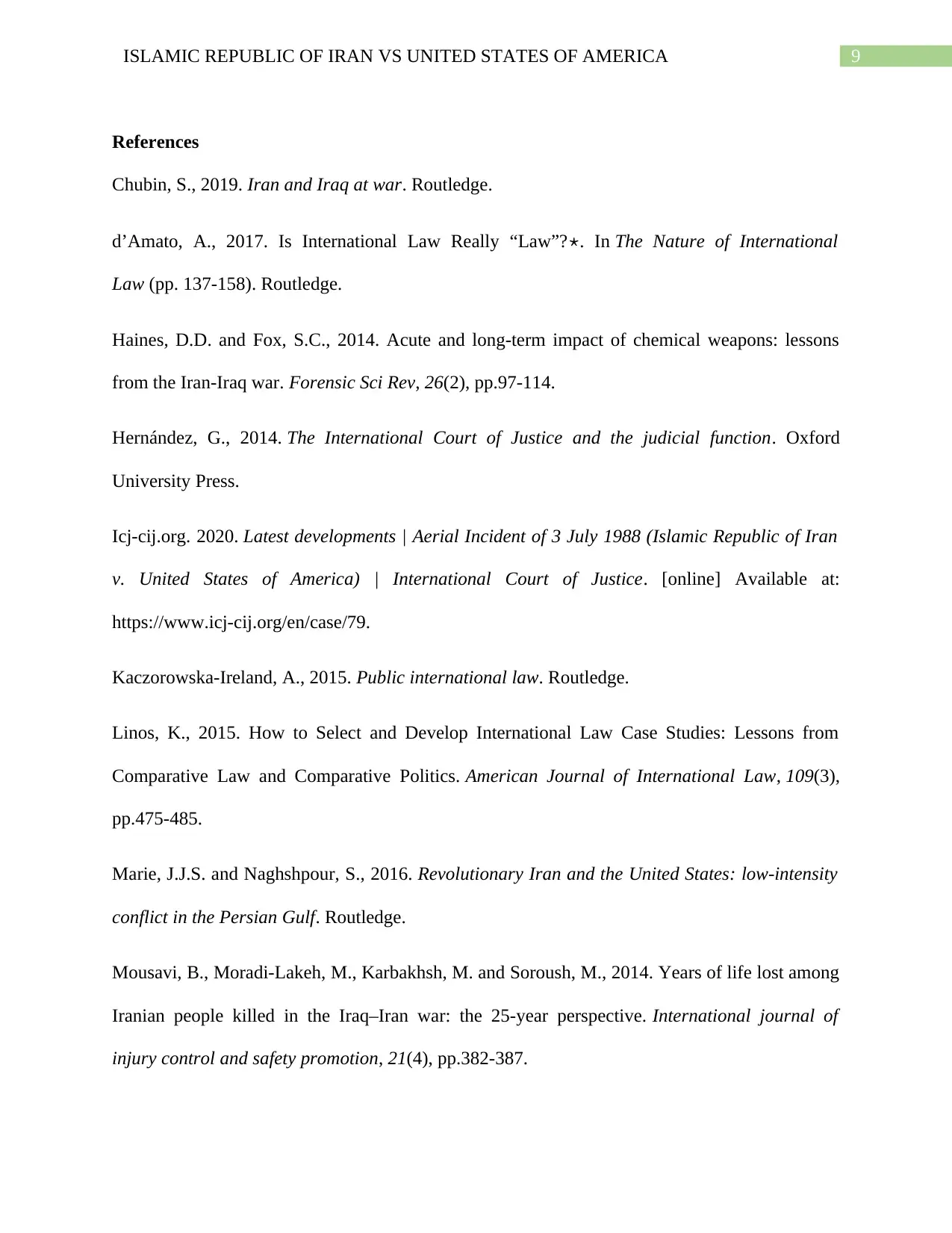
9ISLAMIC REPUBLIC OF IRAN VS UNITED STATES OF AMERICA
References
Chubin, S., 2019. Iran and Iraq at war. Routledge.
d’Amato, A., 2017. Is International Law Really “Law”?⋆. In The Nature of International
Law (pp. 137-158). Routledge.
Haines, D.D. and Fox, S.C., 2014. Acute and long-term impact of chemical weapons: lessons
from the Iran-Iraq war. Forensic Sci Rev, 26(2), pp.97-114.
Hernández, G., 2014. The International Court of Justice and the judicial function. Oxford
University Press.
Icj-cij.org. 2020. Latest developments | Aerial Incident of 3 July 1988 (Islamic Republic of Iran
v. United States of America) | International Court of Justice. [online] Available at:
https://www.icj-cij.org/en/case/79.
Kaczorowska-Ireland, A., 2015. Public international law. Routledge.
Linos, K., 2015. How to Select and Develop International Law Case Studies: Lessons from
Comparative Law and Comparative Politics. American Journal of International Law, 109(3),
pp.475-485.
Marie, J.J.S. and Naghshpour, S., 2016. Revolutionary Iran and the United States: low-intensity
conflict in the Persian Gulf. Routledge.
Mousavi, B., Moradi-Lakeh, M., Karbakhsh, M. and Soroush, M., 2014. Years of life lost among
Iranian people killed in the Iraq–Iran war: the 25-year perspective. International journal of
injury control and safety promotion, 21(4), pp.382-387.
References
Chubin, S., 2019. Iran and Iraq at war. Routledge.
d’Amato, A., 2017. Is International Law Really “Law”?⋆. In The Nature of International
Law (pp. 137-158). Routledge.
Haines, D.D. and Fox, S.C., 2014. Acute and long-term impact of chemical weapons: lessons
from the Iran-Iraq war. Forensic Sci Rev, 26(2), pp.97-114.
Hernández, G., 2014. The International Court of Justice and the judicial function. Oxford
University Press.
Icj-cij.org. 2020. Latest developments | Aerial Incident of 3 July 1988 (Islamic Republic of Iran
v. United States of America) | International Court of Justice. [online] Available at:
https://www.icj-cij.org/en/case/79.
Kaczorowska-Ireland, A., 2015. Public international law. Routledge.
Linos, K., 2015. How to Select and Develop International Law Case Studies: Lessons from
Comparative Law and Comparative Politics. American Journal of International Law, 109(3),
pp.475-485.
Marie, J.J.S. and Naghshpour, S., 2016. Revolutionary Iran and the United States: low-intensity
conflict in the Persian Gulf. Routledge.
Mousavi, B., Moradi-Lakeh, M., Karbakhsh, M. and Soroush, M., 2014. Years of life lost among
Iranian people killed in the Iraq–Iran war: the 25-year perspective. International journal of
injury control and safety promotion, 21(4), pp.382-387.
Secure Best Marks with AI Grader
Need help grading? Try our AI Grader for instant feedback on your assignments.
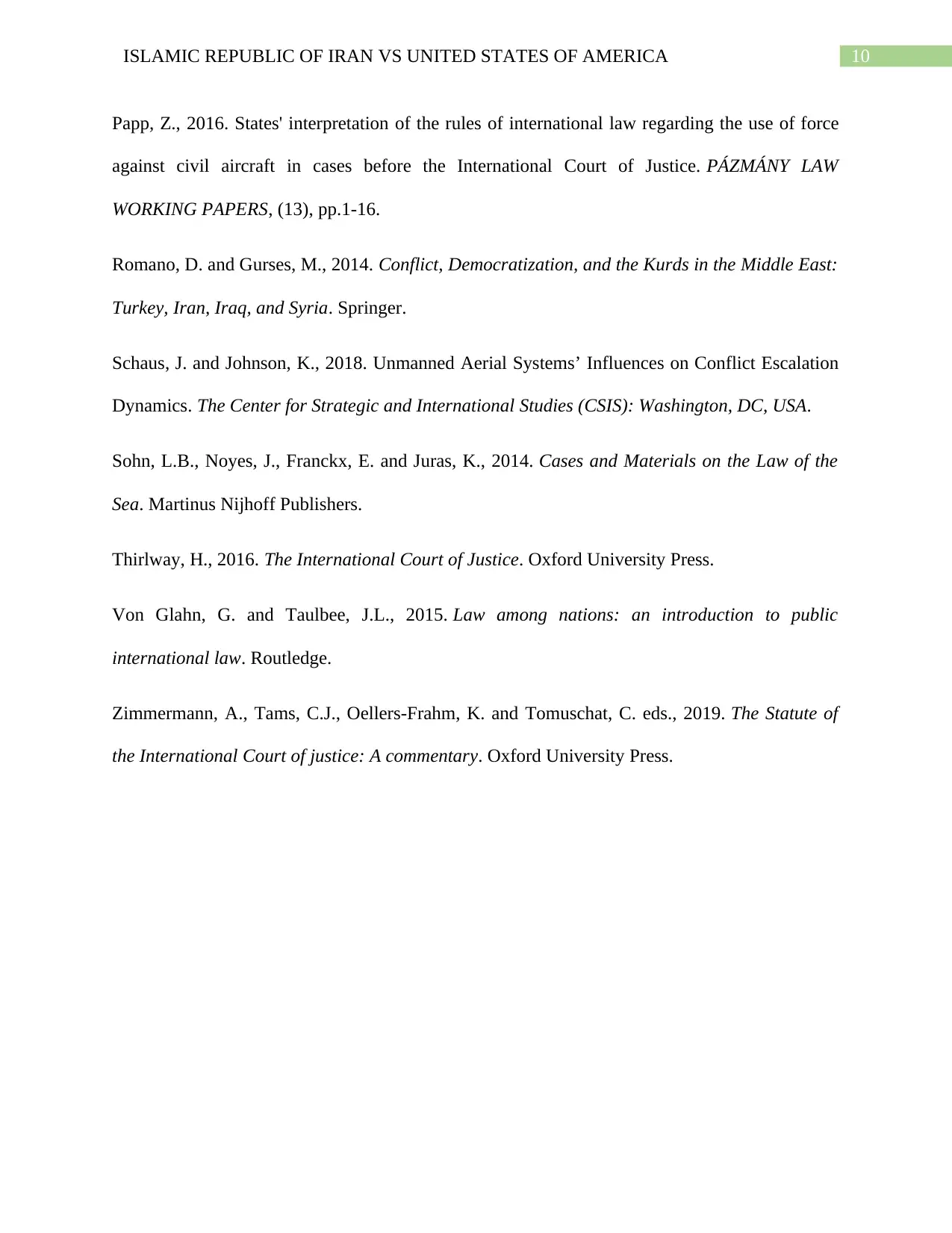
10ISLAMIC REPUBLIC OF IRAN VS UNITED STATES OF AMERICA
Papp, Z., 2016. States' interpretation of the rules of international law regarding the use of force
against civil aircraft in cases before the International Court of Justice. PÁZMÁNY LAW
WORKING PAPERS, (13), pp.1-16.
Romano, D. and Gurses, M., 2014. Conflict, Democratization, and the Kurds in the Middle East:
Turkey, Iran, Iraq, and Syria. Springer.
Schaus, J. and Johnson, K., 2018. Unmanned Aerial Systems’ Influences on Conflict Escalation
Dynamics. The Center for Strategic and International Studies (CSIS): Washington, DC, USA.
Sohn, L.B., Noyes, J., Franckx, E. and Juras, K., 2014. Cases and Materials on the Law of the
Sea. Martinus Nijhoff Publishers.
Thirlway, H., 2016. The International Court of Justice. Oxford University Press.
Von Glahn, G. and Taulbee, J.L., 2015. Law among nations: an introduction to public
international law. Routledge.
Zimmermann, A., Tams, C.J., Oellers-Frahm, K. and Tomuschat, C. eds., 2019. The Statute of
the International Court of justice: A commentary. Oxford University Press.
Papp, Z., 2016. States' interpretation of the rules of international law regarding the use of force
against civil aircraft in cases before the International Court of Justice. PÁZMÁNY LAW
WORKING PAPERS, (13), pp.1-16.
Romano, D. and Gurses, M., 2014. Conflict, Democratization, and the Kurds in the Middle East:
Turkey, Iran, Iraq, and Syria. Springer.
Schaus, J. and Johnson, K., 2018. Unmanned Aerial Systems’ Influences on Conflict Escalation
Dynamics. The Center for Strategic and International Studies (CSIS): Washington, DC, USA.
Sohn, L.B., Noyes, J., Franckx, E. and Juras, K., 2014. Cases and Materials on the Law of the
Sea. Martinus Nijhoff Publishers.
Thirlway, H., 2016. The International Court of Justice. Oxford University Press.
Von Glahn, G. and Taulbee, J.L., 2015. Law among nations: an introduction to public
international law. Routledge.
Zimmermann, A., Tams, C.J., Oellers-Frahm, K. and Tomuschat, C. eds., 2019. The Statute of
the International Court of justice: A commentary. Oxford University Press.
1 out of 11
Related Documents
Your All-in-One AI-Powered Toolkit for Academic Success.
+13062052269
info@desklib.com
Available 24*7 on WhatsApp / Email
![[object Object]](/_next/static/media/star-bottom.7253800d.svg)
Unlock your academic potential
© 2024 | Zucol Services PVT LTD | All rights reserved.


